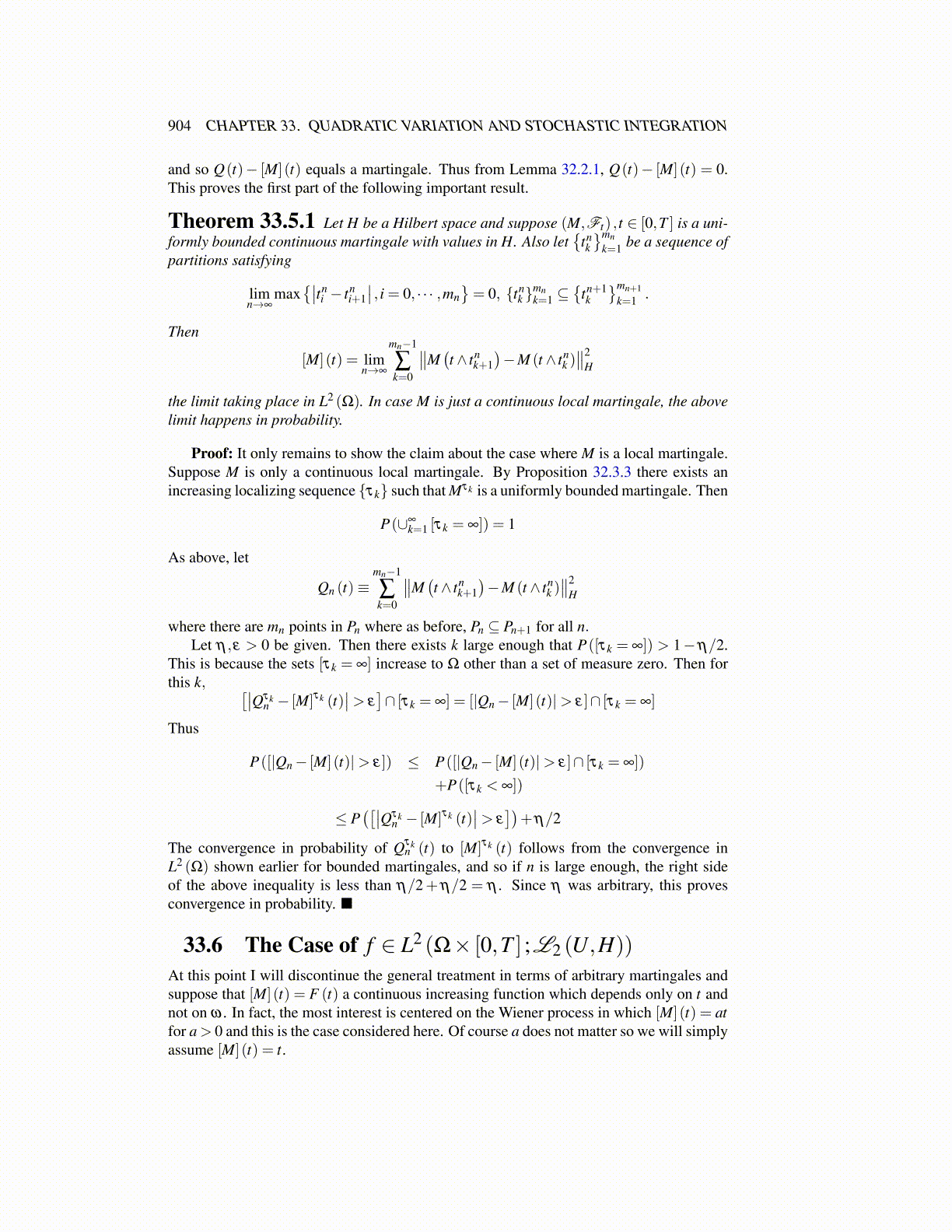
904 CHAPTER 33. QUADRATIC VARIATION AND STOCHASTIC INTEGRATION
and so Q(t)− [M] (t) equals a martingale. Thus from Lemma 32.2.1, Q(t)− [M] (t) = 0.This proves the first part of the following important result.
Theorem 33.5.1 Let H be a Hilbert space and suppose (M,Ft) , t ∈ [0,T ] is a uni-formly bounded continuous martingale with values in H. Also let
{tnk
}mnk=1 be a sequence of
partitions satisfying
limn→∞
max{∣∣tn
i − tni+1∣∣ , i = 0, · · · ,mn
}= 0, {tn
k }mnk=1 ⊆
{tn+1k
}mn+1k=1 .
Then
[M] (t) = limn→∞
mn−1
∑k=0
∥∥M(t ∧ tn
k+1)−M (t ∧ tn
k )∥∥2
H
the limit taking place in L2 (Ω). In case M is just a continuous local martingale, the abovelimit happens in probability.
Proof: It only remains to show the claim about the case where M is a local martingale.Suppose M is only a continuous local martingale. By Proposition 32.3.3 there exists anincreasing localizing sequence {τk} such that Mτk is a uniformly bounded martingale. Then
P(∪∞k=1 [τk = ∞]) = 1
As above, let
Qn (t)≡mn−1
∑k=0
∥∥M(t ∧ tn
k+1)−M (t ∧ tn
k )∥∥2
H
where there are mn points in Pn where as before, Pn ⊆ Pn+1 for all n.Let η ,ε > 0 be given. Then there exists k large enough that P([τk = ∞]) > 1−η/2.
This is because the sets [τk = ∞] increase to Ω other than a set of measure zero. Then forthis k, [∣∣Qτk
n − [M]τk (t)∣∣> ε
]∩ [τk = ∞] = [|Qn− [M] (t)|> ε]∩ [τk = ∞]
Thus
P([|Qn− [M] (t)|> ε]) ≤ P([|Qn− [M] (t)|> ε]∩ [τk = ∞])
+P([τk < ∞])
≤ P([∣∣Qτk
n − [M]τk (t)∣∣> ε
])+η/2
The convergence in probability of Qτkn (t) to [M]τk (t) follows from the convergence in
L2 (Ω) shown earlier for bounded martingales, and so if n is large enough, the right sideof the above inequality is less than η/2+η/2 = η . Since η was arbitrary, this provesconvergence in probability. ■
33.6 The Case of f ∈ L2 (Ω× [0,T ] ;L2 (U,H))
At this point I will discontinue the general treatment in terms of arbitrary martingales andsuppose that [M] (t) = F (t) a continuous increasing function which depends only on t andnot on ω . In fact, the most interest is centered on the Wiener process in which [M] (t) = atfor a> 0 and this is the case considered here. Of course a does not matter so we will simplyassume [M] (t) = t.